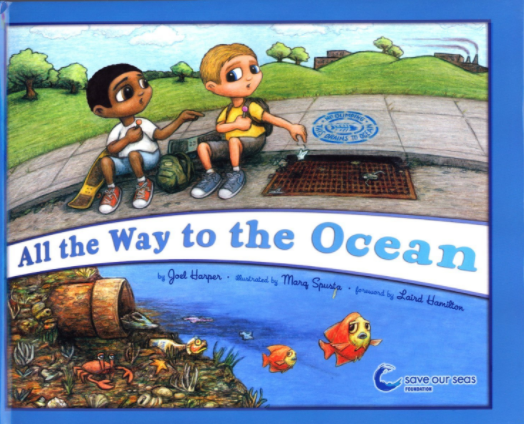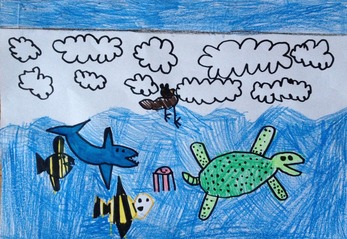Lesson Four
Content Area StandardsScience:
Social Studies:
ObjectivesStudents will be able to:
ConceptsSystem - Interdependence
|
Prior PreperationReady presentation, videos and Google Earth or other map
Prerequsite KnowledgeStudents must have knowledge of the impact that human activity has on the availability of natural resources, and that natural resources are used to create materials. These man-made materials often contain substances that are toxic to humans and animals.
AssessmentCreative Questions
Students will chose an animal (land, sea or sky) and think about at garbage pollution from that animal's perspective. The students will draw a picture of the animal in its habitat, and write a letter to humans from the animal's point of view. The letter will address how they are affected by garbage pollution and what they want humans to do differently. AccommodationsUniversal Design in place to accommodate exceptionalities.
|
Materials and Resources
|
Materials:
Map such as Google Earth, art paper, drawing and coloring materials, link to > Prezi < Click here Video Resources: Formanek, I., Loo, J., Phillips, M. &Walsh, N. (n.d.). Plastic Island. Retrieved from http://www.cnn.com/interactive/2016/12/world/midway-plastic-island/ TedEd. (April 21, 2015). What really happens to the plastic you throw away?. Retrieved from https://www.youtube.com/watch?v=_6xlNyWPpB8 Sites for Additional Research: In Your State | Bag the Ban. (n.d.). Ban the Bag. Retrieved fromhttp://www.bagtheban.com/in-your-state Bye Bye Plastic Bags | Say No To Plastic Bags. (n.d.). Bye Bye Plastic Bags. Retrieved from http://www.byebyeplasticbags.org/ |
Books:
All the Way to the Ocean Joel Harper. (February 1, 2006). All the way to the ocean. Claremont, CA: Freedom Three Publishing. |
Instructional Procedure
|
What Really Happens to the Stuff You Throw Away?
|
|
Destination #1: Landfill
- How does a landfill work?
- All of our waste has to go somewhere and landfills are where a majority of it ends up. Landfills have strict restrictions (rules) that they have to abide by (obey) in order to reduce harm to the environment. However, this is not foolproof and many things can go wrong. It is becoming harder to find places for landfills because they take up a lot of space and there are restrictions as to where they can go.
- Landfills are lined with a plastic and clay barrier to keep all of the harmful toxins and pollution contained.
- Garbage is transported from all over the city and dumped into cells within the liner, each one holding a day’s worth of trash. Cells are compacted (smooshed together) by machinery, then covered with dirt. The landfill must be covered with a layer of dirt in attempt to keep birds and other animals out.
- Landfills are kept as dry as possible by filtering garbage for liquids and by using a storm drainage system to channel water away from the landfill.
- Two harmful byproducts of landfills are leachate and methane gas.
- Leachate is like a garbage soup. It is water that has picked up chemicals from trash in the landfill. Leachate is a big threat to surface water (rivers, lakes, oceans) and groundwater (underground). All waterways are connected, therefore leachate has the potential to affect wildlife and habitats far away.
- Methane gas is produced from the anaerobic (without air) breakdown of materials within a landfill. Since landfills are compacted and covered with dirt, much more methane is produced than if materials were left uncovered. Methane is a greenhouse gas that contributes to climate change. It is also highly flammable and can explode. In order to prevent this, methane is vented and sometimes burned off in a controlled way. Methane is now being extracted by (taken out of) some landfills to be used as fuel to do things like heat your home.
- When a landfill is completed properly, it can become a park, golf course, or even a playground.
Where Is YOUR Landfill?
- After the video show the local Landfill on a map. If using google earth, turn on the “dead zone” filter. Fish icons will appear wherever there is a deadzone. Dead zones are oxygen depleted coastal waters that result from nutrient pollution. They typically surround major industrial and agricultural centers.
- Conversation starters and questions:
- What is notable about the location of the landfill? Point out waterways, farms, and homes around the landfill. Follow any rivers near the landfill and see where they lead.
- What effects might the landfill have on all of the surrounding people, animals, and environment? Investigate the dead zones - are there more down river of the landfill and near the city center than upriver? Why?
- What are some benefits and consequences of a landfill as a waste management practice? To keep the conversation going, remind students that although waste can be reduced, it is an inevitable part of life in modern society and waste must go somewhere.
Destination #2: Waterway
- All waterways are connected. Litter can travel from anywhere on land, down a river, and into the ocean.
- Play video, Plastic Island (10-14 min. *Teachers, preview the video as there are some images of wildlife death that may be needed to be skipped over 5:00-7:20)
- Video Recap:
- There are 5 main ocean gyres. A gyre is a large system of circular ocean currents formed by wind patterns and the Earth's rotation.
- Show the Great Pacific Garbage Patch on a map. If using Google Earth, turn on the marine protected area filter. Marine Protected Areas restrict human activity in order to protect natural resources such as water and wildlife. Show students how far away other land is and how far trash travels to get to the atoll. Plastic floats from cities, 1,000s of miles away.
- Video Recap:
- Play video, Plastic Island (10-14 min. *Teachers, preview the video as there are some images of wildlife death that may be needed to be skipped over 5:00-7:20)
|
By 2050 there will be more plastic in the ocean than fish.
- Microplastics are tiny particles of plastic that have broken down from larger plastic items in the water.
- The problem with microplastics:
- The tiny particles act like a sponge absorbing other pollutants in the water.
- Marine animals eat the plastic. When the particles get small enough they can cross tissue membranes so fish don’t even need to mistakenly eat them. Fish can absorb plastic into their bodies by simply swimming in the water.
- Microplastics are harmful to animals because they have soaked up all the other toxins in the water. Animals have a harder time reproducing. They also can become sick and be unable to defend themselves from predators. Microplastics are harmful to humans because people eat seafood that ate the plastic. Toxins and microplastics may also be in drinking water and the water we swim in.
- The problem with microplastics:
|
If I Were a Fish
|
,
Additional Research - Innovative Solutions
Lesson Vocabulary: Anaerobic, Dead Zone, Gyre, Leachate, Marine Protected Area, Methane, Microplastic, Toxin
Additional Research - Innovative Solutions
- Some cities have banned styrofoam and certain plastics like shopping bags and take out containers. Unfortunately, some states have banned banning one time use items like plastic shopping bags.
- byebyeplasticbags.org - Kids making a difference!
- banthebag.com - Has your city or state already banned plastic shopping bags?
- washingtonpost.com - Michigan Idaho, Arizona and Missouri protect businesses from having to comply with additional regulations.
Lesson Vocabulary: Anaerobic, Dead Zone, Gyre, Leachate, Marine Protected Area, Methane, Microplastic, Toxin



